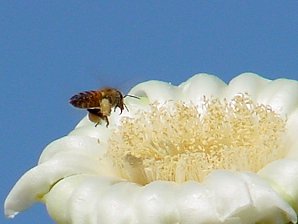Saguaro Cactus, Cereus giganteus, Carnegiea gigantea
 |
| Saguaro Cactus, Cereus giganteus or Carnegiea gigantea Photo Of Arizona State Flower And Italian Honey Bee, Apis mellifera ligustica. |
|---|
 |
| Saguaro Cactus, Cereus giganteus, Carnegiea gigantea - Arizona State Flower And White - Winged Dove, Zenaida asiatica. |
 |  |
| Saguaro Cactus, Carnegiea gigantea (Cereus giganteus) They Cover Whole Hillsides! | "Sentinals Of The Desert" Reach The Age Of 200 - 300 Years Old! |
|---|---|
 |  |
| Saguaro Cactus, Carnegiea gigantea (Cereus giganteus) Juvenile Plant Shown This Plant Perhaps 40 Years Old | Creamy-White, 3-Inch-Wide Flowers With Yellow Centers Bloom May And June Lesser Long-Nosed Bat Migration Timed To Their Flower Opening |
 |  |
| Honey Bees Love Saguaro Flowers | There are over 1000 Species Of Bees In The Sonoran Desert |
 |  |
| Lesser Long-Nosed Bats Leptonycteris curasoae yerbabuenae | Are Very Important Pollinators Of The Saguaro Cactus |
 |  |
| Fruit Bright-Red, Pulpy Flesh | Ripe Saguaro Fruit |
 |  |
| Saguaro Cactus Skelton | Saguaro Cactus, Cereus giganteus or Carnegiea gigantea |
 |  |
| Tohono O'odham Men Demonstrating Removal Of Saguaro Fruit | Generations Of Tohono O'odham Women Have Harvested The Bright-Red, Pulpy Flesh Fruit |
 |  |
| Processing The Scarlet Colored Saguaro Fruit Pulp Into A Syrup Tasting Like Pomegranate | The Syrup Then Fermented Into Nawait A Ceremonial Cactus Wine |
Saguaro Cactus The saguaro cactus is a dominant form of the Sonoran Desert. A young saguaro takes nearly a decade to reach one inch tall, it can reach heights of about fifty feet, which makes it the largest cactus in the United States. The saguaro is a single-stemmed, columnar cactus supported by woody ribs. The skin of the cactus is light green and waxy. Spines are clustered down the length of the ridges. At seventy-five years old, the cactus begins to sprout arms that grow parallel to the body. As many as fifty arms have been found on older saguaros estimated to be 200 - 300 years old. A Saguaro cactus can weigh over nine tons. Saguaro flowers are pollinated by nectar feeding bats, birds and insects. While a single fruit of a saguaro can produce over 2000 jet - black seeds; only a few of the seeds that a saguaro produces in its lifetime, will germinate and grow to maturity. While many animals, birds, and insects enjoy the fruit of the saguaro, there are many of these creatures which also make their homes in the Saguaro. The most widely known of the birds are the Gila Woodpecker, which creates many of the nest holes seen in mature saguaro stems. Each year the woodpecker creates a new nest hole, and the previous one is then occupied by insects, lizards or occasionally by the Elf Owl. The gilded flicker also produces nest holes in saguaros. Occasionally, the major branches of saguaros can have large twig-nests of hawks such as the red-tailed hawk or the Harris hawk. At Alamo Lake there are Bald Eagles which nest on the top branches of the Saguaro. Saguaro are located all over the state of Arizona mainly in the Sonora Desert. While there are three National Parks dedicated to the protection of the Saguaro, there are many other locations in Arizona with far better displays of Saguaros than what are in the National Parks. While most Saguaro cacti grow in the typical fashion, a few individuals will grow in an atypical form known as a cristate or crested saguaro. These bizarre looking forms often grow as a crest
Height: Up To About 15' - 50' Tall. |